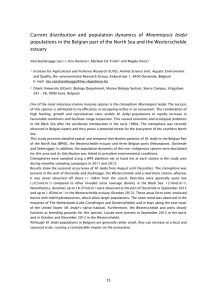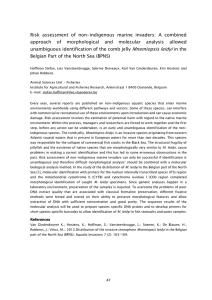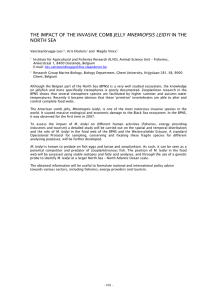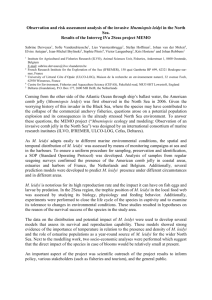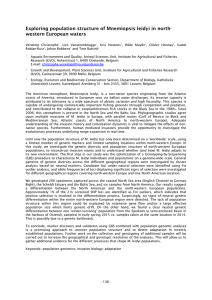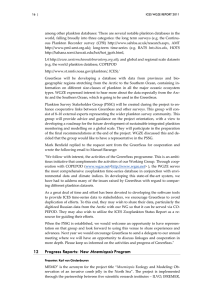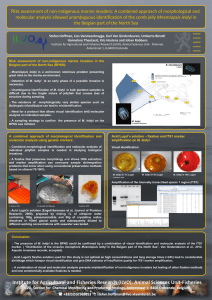Mnemiopsis leidyi in northern European waters?
advertisement
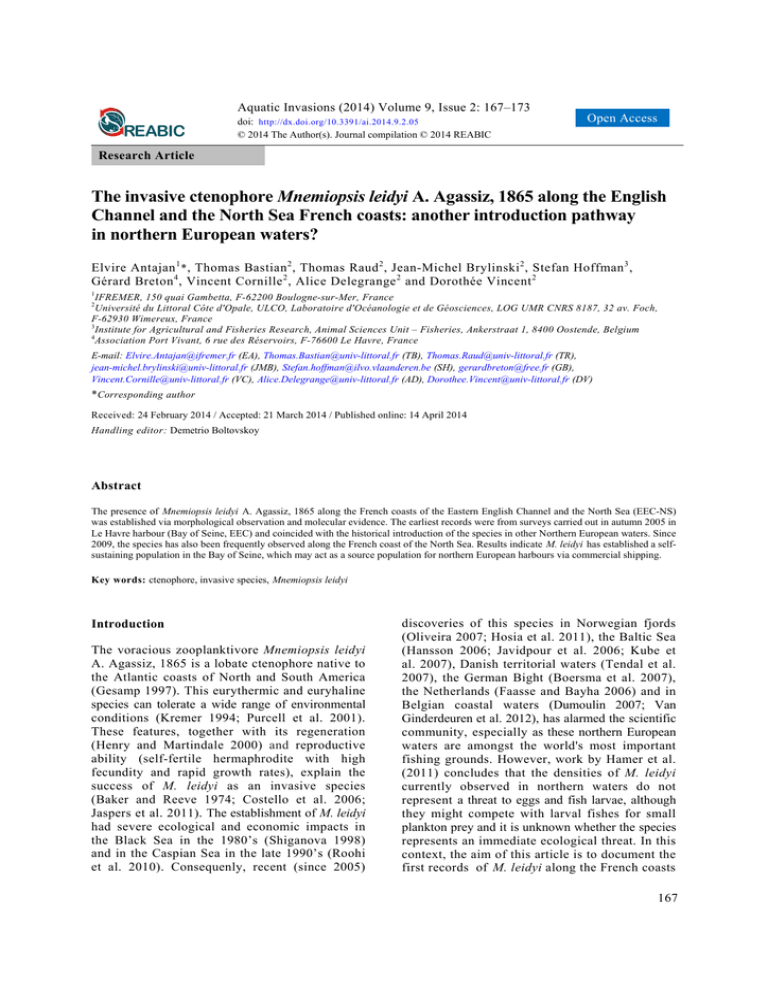
Aquatic Invasions (2014) Volume 9, Issue 2: 167–173 doi: http://dx.doi.org/10.3391/ai.2014.9.2.05 © 2014 The Author(s). Journal compilation © 2014 REABIC Open Access Research Article The invasive ctenophore Mnemiopsis leidyi A. Agassiz, 1865 along the English Channel and the North Sea French coasts: another introduction pathway in northern European waters? Elvire Antajan 1 * , Thomas Bastian 2 , Thomas Raud 2 , Jean-Michel Brylinski 2 , Stefan Hoffman 3 , Gérard Breton 4 , Vincent Cornille 2 , Alice Delegrange 2 and Dorothée Vincent 2 1 IFREMER, 150 quai Gambetta, F-62200 Boulogne-sur-Mer, France Université du Littoral Côte d'Opale, ULCO, Laboratoire d'Océanologie et de Géosciences, LOG UMR CNRS 8187, 32 av. Foch, F-62930 Wimereux, France 3 Institute for Agricultural and Fisheries Research, Animal Sciences Unit – Fisheries, Ankerstraat 1, 8400 Oostende, Belgium 4 Association Port Vivant, 6 rue des Réservoirs, F-76600 Le Havre, France 2 E-mail: Elvire.Antajan@ifremer.fr (EA), Thomas.Bastian@univ-littoral.fr (TB), Thomas.Raud@univ-littoral.fr (TR), jean-michel.brylinski@univ-littoral.fr (JMB), Stefan.hoffman@ilvo.vlaanderen.be (SH), gerardbreton@free.fr (GB), Vincent.Cornille@univ-littoral.fr (VC), Alice.Delegrange@univ-littoral.fr (AD), Dorothee.Vincent@univ-littoral.fr (DV) *Corresponding author Received: 24 February 2014 / Accepted: 21 March 2014 / Published online: 14 April 2014 Handling editor: Demetrio Boltovskoy Abstract The presence of Mnemiopsis leidyi A. Agassiz, 1865 along the French coasts of the Eastern English Channel and the North Sea (EEC-NS) was established via morphological observation and molecular evidence. The earliest records were from surveys carried out in autumn 2005 in Le Havre harbour (Bay of Seine, EEC) and coincided with the historical introduction of the species in other Northern European waters. Since 2009, the species has also been frequently observed along the French coast of the North Sea. Results indicate M. leidyi has established a selfsustaining population in the Bay of Seine, which may act as a source population for northern European harbours via commercial shipping. Key words: ctenophore, invasive species, Mnemiopsis leidyi Introduction The voracious zooplanktivore Mnemiopsis leidyi A. Agassiz, 1865 is a lobate ctenophore native to the Atlantic coasts of North and South America (Gesamp 1997). This eurythermic and euryhaline species can tolerate a wide range of environmental conditions (Kremer 1994; Purcell et al. 2001). These features, together with its regeneration (Henry and Martindale 2000) and reproductive ability (self-fertile hermaphrodite with high fecundity and rapid growth rates), explain the success of M. leidyi as an invasive species (Baker and Reeve 1974; Costello et al. 2006; Jaspers et al. 2011). The establishment of M. leidyi had severe ecological and economic impacts in the Black Sea in the 1980’s (Shiganova 1998) and in the Caspian Sea in the late 1990’s (Roohi et al. 2010). Consequenly, recent (since 2005) discoveries of this species in Norwegian fjords (Oliveira 2007; Hosia et al. 2011), the Baltic Sea (Hansson 2006; Javidpour et al. 2006; Kube et al. 2007), Danish territorial waters (Tendal et al. 2007), the German Bight (Boersma et al. 2007), the Netherlands (Faasse and Bayha 2006) and in Belgian coastal waters (Dumoulin 2007; Van Ginderdeuren et al. 2012), has alarmed the scientific community, especially as these northern European waters are amongst the world's most important fishing grounds. However, work by Hamer et al. (2011) concludes that the densities of M. leidyi currently observed in northern waters do not represent a threat to eggs and fish larvae, although they might compete with larval fishes for small plankton prey and it is unknown whether the species represents an immediate ecological threat. In this context, the aim of this article is to document the first records of M. leidyi along the French coasts 167 E. Antajan et al. Figure 1. Sampling site records of Mnemiopsis leidyi in the Eastern English Channel – North Sea ecosystem; (A) Western Bay of Seine; (B) Eastern Bay of Seine; (C) French coasts of the North Sea. of the Eastern English Channel-North Sea ecosystem (EEC-NS), and discuss possible invasion routes from its native range. Methods Sample sites were located along the French coast between the western part of the Bay of Seine (BoS) and the North Sea (Figure 1A–C). A variety of sampling devices and observations were used depending on the sampling location (Table 1S). Scuba diving observations by amateurs were the source of most M. leidyi records in the BoS (mainly in Le Havre Harbour). Photographs taken by divers (Figure 2A–C) permitted morphological identification of M. leidyi based on the position of the oral lobes extending to the apical statocyst (sense organ) over nearly the entire body length (Faasse and Bayha 2006; Oliveira and Migotto 2006). 168 Within research monitoring surveys, two types of plankton nets were used along the French coast of the North sea for quantitative estimate of M. leidyi, a WP2 net (opening area 0.25m² and 200 µm mesh size; Fraser 1968a) and a WP3 net (opening area 1.0 m² and 1.0 mm mesh size; Fraser 1968b). The M. leidyi record from the Seine estuary represents specimens collected during a bottom trawl survey (280 40cm aperture, 20 mm mesh size). When available, abundance and approximate sizes are provided in Table 1S of supplementary material. When actual numbers per m3 were not available, abundance was expressed as less than ten (+), sparse (++), or common (+++). Freshly caught individuals from all sites were observed and identified alive, and some of them were preserved in 70–100 % ethanol and stored at 4°C for further genetic analyses (following Van Ginderdeuren et al. 2012; see superscript in Table 1S). Mnemiopsis leidyi in the English Channel and North Sea French coasts Figure 2. Mnemiopsis leidyi (A) from the Eastern Bay of Seine (Le Havre harbour) – photograph by G. Breton on the 25.09.2005; (B) from the Western Bay of Seine (Tatihou Island; Length 4–5 cm) – photograph by F. Chevallier on the 26.09.2011; (C) from the French coasts of the North Sea (Dunkirk Harbour; Length 6 cm) – photograph by J.M. Brylinski in kreisel tank. Arrows indicate the position of the statocyst (1) and lobes insertion (2), near the aboral end of the body in M. leidyi, a distinctive characteristic of the species. Results All observed specimens collected during this study were lobate individuals, and no cyddipid larvae were recorded. The earliest records of M. leidyi that we could verify with photographs provided by divers (Figure 2A) were from Le Havre Harbour (Figure 1B and Table 1S, N° 8, 12 and 13) in September and October 2005. Since then, there have been frequent observations of individuals (ranging from 3 to 8 cm in length) reported during diving sessions in the same area (Figure 1B and Table 1S N° 4 to 16). Some individuals collected in 2011 (Figure 1B and Table 1S, N° 9 and 10) were genetically identified and confirmed our initial morphological identification (E. Antajan, unpublished data). In Le Havre Harbour, the greatest numbers of M. leidyi were recorded during July to October; however, a few individuals were still observed in winter (Figure 1B and Table 1S, N° 13). The first records of M. leidyi in the North Sea were made in September 2009 (Antajan et al. 2010, Figure 1C; N° 24 to 27). Specimens of M. leidyi were also collected during 2010, 2012 and 2013 in the two nearby harbours of Calais (N° 19 to 23) and Dunkirk (N° 28 to 32). M. leidyi was recorded from these sites from September to December at temperature ranging from 5.5 to 20.2°C and salinity between 29.7 and 34.9. In January 2011, the launch of the European MEMO project (InterReg IVa-2 seas, Mnemiopsis Ecology and Modelling: Observation of an invasive comb jelly in the North Sea) was accompanied by a major public communication effort and has led many reports by citizens of the presence of the species in the BoS (Figure 1A–B and Table 1S, N° 1 to 3 and 18). Following the collection of M. leidyi in the Seine estuary during a bottom trawl survey (Figure 1B and Table 1S, N°17), the Somme, Canche and Authie estuaries (Figure 3), and a long-term monitoring station (SOMLIT stations) were also surveyed to assess whether M. leidyi had spread northward. However, no M. leidyi were detected at any of these four sites. Discussion Mnemiopsis leidyi has been present along the French coast since at least 2005. Earlier occurrence is possible; however, the routine monitoring surveys along the French coasts of the North Sea (e.g. Calais, Dunkirk and Gravelines) use a formalin solution to preserve zooplankton samples immediately after collection. This causes M. leidyi to disintegrate and makes species identification, counting, and measuring practically impossible (Kube et al. 2007; Engell-Sørensen et al. 2009; Sullivan and Gifford 2009). Purcell (1988) presented an identification method for formaldehydepreserved samples based on identification of M. leidyi tentacle bulbs. This method was tested on 2005–2009 formalin-fixed samples but given the very low number of individuals (< 2 ind.m-3) and the large amount of particulate matter in the 169 E. Antajan et al. Figure 3. Mnemiopsis leidyi records and possible introduction and spreading vectors in the English Channel – North Sea ecosystem. Current circulation is based on Edwards (1968), Otto et al. (1990) and Lazure and Desmare (2011). samples, tentacle bulbs were impossible to detect. Since our 2009 record of M. leidyi in nonpreserved samples (Figure 1C and Table 1S, N° 24–26), zooplankton sampling techniques were reconsidered and collected samples were first examined while specimens were alive before sample preservation. This new strategy resulted in additional records in the North Sea, and we recommend a systematic visual inspection of still living material for ctenophores and similar taxa prior to sample preservation in future zooplankton surveys. Our first record of M. leidyi in 2005 in Le Havre Harbour coincides with the first record of M. leidyi in the northern part of the North Sea Oslo fjord in Norway (Oliveira 2007). Although the North Atlantic Current has previously been considered as a potential introduction vector of M. leidyi in the North Sea (Oliveira 2007), it could not explain our simultaneous record in the Bay of Seine (BoS) because this current does not extend into the English Channel (Otto et al. 1990). Instead, our results suggest there were multiple and simultaneous introductions of the species in the main harbours of Northern Europe, 170 presumably by means of ballast water (Vinogradov et al. 1989; Ivanov et al. 2000; Oliveira et al. 2007; Fuentes et al. 2010 and references therein). Large ships crossing the Strait of Dover towards the North Sea regularly stop in the Calais and Dunkirk harbours and can also visit the large European harbours such as Le Havre (France), Rotterdam (Netherlands), Anvers, Zeebrugge (Belgium) and Hamburg (Germany; Figure 3). The introduction pattern of M. leidyi by cargo ships in the EEC-NS would, therefore, result from trans-Atlantic (e.g. East coast of Mexico and USA) and local ship transits as was observed along the Belgium and Dutch coasts (Wolff 2005; Faasse and Bahya 2006; Van Ginderdeuren et al. 2012) and in the Mediterranean Sea (Bolte et al. 2013; Ghabooli et al. 2013). Advection processes and natural transport (drift, internal circulation) have previously been identified as vectors of secondary spread for M. leidyi (Lehmann and Javidpour 2010; Schaber et al. 2011; Van Ginderdeuren et al. 2012). Therefore, it is possible that M. leidyi introduced along the French coast of the North Sea originated from adjacent regions (e.g. Belgium or BoS). Mnemiopsis leidyi in the English Channel and North Sea French coasts The spread of M. leidyi southward from the North Sea, where established populations are observed (Faasse and Bayha 2006; Van Ginderdeuren et al. 2012), is unlikely because the residual tidal transport is oriented northward; water masses typically drift from the English Channel to the North Sea (Otto et al. 1990; Brylinski et al. 1991; Figure 3). North-easterly winds can at times reverse the general circulation pattern and induce southward spreading of plankton organisms (Dauvin et al. 2007), but these conditions did not prevail during our sampling periods (autumn 2009-2010, 2012, 2013 and January 2010). Recurring records year-round in the BoS since 2005 suggest the existence of another potential, self-maintaining, source population (sensu Costello et al. 2012). However, a northward spread from the BoS is also unlikely as no M. leidyi were recorded in the main EEC estuaries (Somme, Canche and Authie) nor at the SOMLIT stations (Figure 3). Natural expansion from the Seine estuary would likely lead to M. leidyi spreading westward, which is consistent with the net seaward transport in the Seine estuary (Wang et al. 1995), the general water circulation pattern in the BoS (Le Hir et al. 1985; Lazure and Desmare 2011), and observations of M. leidyi in the western part of the BoS in autumn 2011 (Figures 1A and 3; N° 1 and 2 Table 1S). Thus, simple water drifting as a vector of M. leidyi spreading from the BoS to the French coast of the North Sea is unlikely, and records suggest the existence of distinct North Sea and a BoS populations. Although the BoS population seems to be selfsustaining, the absence of M. leidyi in winter or year-round in the North Sea (in 2011) suggests a regular pattern of elimination and re-inoculation more typical of a sink population (sensu Costello 2012). Two main invasion pathways were identified for M. leidyi introductions in Eurasia (Ghabooli et al. 2011; Reusch et al. 2010; Costello et al. 2012). While specimens from the Gulf of Mexico invaded the Black Sea and then the Caspian Sea, specimens from the Baltic Sea seem to originate from Narragansett Bay (USA). Studies of M. leidyi population genetics would permit assessment of whether EEC-NS specimens are individuals imported from their native habitats or represent mixed populations resulting from water exchanges between the EEC-NS harbours during ship transit, as was demonstrated in the Mediterranean Sea (Fuentes et al. 2010; Ghabooli et al. 2013). Our seasonal and spatial records of M. leidyi at temperature ranging from 5.5 to 20.2°C and salinity from 29.7 to 34.9 are consistent with its euryhaline and eurythermal nature (Kremer et al. 1994; Purcell et al. 2001). Records of M. leidyi are also consistent with its versatile opportunistic zooplanktivorous feeding behaviour, with it being able to exploit the high standing stocks of copepods (Grattepanche et al. 2010), fish larvae (Amara 2002; Amara et al. 2000), and bivalve larvae characterizing the EEC-NS French coastal waters. However, two characteristics of the EECNS ecosystem could represent limiting factors for M. leidyi spreading and survival. First, choppy sea conditions in the EEC-NS ecosystem (high turbulence and tidal mixing; Seuront et al. 1999, 2002; Kesaulya et al. 2008) can cause direct physical damage (Miller 1974; Graham et al. 2001; Mianzan et al. 2010) and decrease feeding efficiency of M. leidyi (Waggett and Costello 1999; Colin et al. 2010). Second, predation by cnidarians (such as Aurelia aurita (Linnaeus, 1758) and Chrysaora hysoscella (Linnaeus, 1767); Javidpour et al. 2009; Hosia and Titelman 2001), ctenophores (such as Beroe gracilis Künne, 1939 and B. cucumis Fabricius, 1780; Hosia et al. 2011; Van Ginderdeuren et al. 2012), or fish (Mianzan et al. 1996; Purcell et al. 2001; Schaber et al. 2011) may limit M. leidyi population size or even persistence. In conclusion, the present study demonstrated that the alien invasive ctenophore M. leidyi has been present along the French coasts of the EECNS ecosystem at least since 2005. If the species has established a population in the BoS, its development and origins in North Sea French harbours (Calais and Dunkirk) are poorly understood. Long-term monitoring, along with population genetics investigations, are therefore needed to address source-sink dynamics of the species and potential establishment along the French coasts of the North Sea. Acknowledgements We gratefully acknowledge all divers of the association Port Vivant and F. Chevallier from Tatihou museum for reporting their observations of Mnemiopsis leidyi and for providing detailed information, photographic evidence and specimen for DNA analyses. We also acknowledge the anonymous reviewers whose constructive comments greatly improved a previous version of this paper. The Gravelines and Dunkirk data were collected within the framework of the research programmes IGA (Impact des Grands Aménagements), Vibrio-Manche and gelatinous plankton surveys conducted by IFREMER and ULCO-LOG with financial support from EDF (Electricité de France). This work was funded by the EU under the InterReg IVa-2seas (MEMO project) programme. 171 E. Antajan et al. References Antajan E, Delesmont R, Dewarumez J-M, Lefebvre A, Luczak C, Warembourg C (2010) Surveillance écologique et halieutique du site de Gravelines, Novembre 2008 - Octobre 2009. IFREMER Technical report, 151 pp Amara R (2002) Localisation et diagnostic de l’état de santé des nourriceries d’espèces d’intérêt halieutique en Manche orientale. Rapport de contrat LT 98040, Ministère de l’Aménagement du Territoire et de l’Environnement, 124 pp Amara R, Lagardere F, Desaunay Y, Marchand J (2000) Metamorphosis and estuarine colonisation in the common sole, Solea solea (L.): implications for recruitment regulation. Oceanologica Acta 23 (4): 469–484, http://dx.doi.org/10.1016/ S0399-1784(00)00134-1 Baker LD, Reeve MR (1974) Laboratory culture of the lobate ctenophore Mnemiopsis mccradyi with notes on feeding and fecundity. Marine Biology 26: 57–62, http://dx.doi.org/10.1007/ BF00389086 Boersma M, Malzahn AM, Greve W, Javidpour J (2007) The first occurrence of the ctenophore Mnemiopsis leidyi in the North Sea. Helgoland Marine Research 61: 153–155, http://dx.doi. org/10.1007/s10152-006-0055-2 Bolte S, Fuentes V, Haslob H, Huwer B, Thibault-Botha D, Angel D, Galil B, Javidpour J, Moss AG, Reusch TBH (2013) Population genetics of the invasive ctenophore Mnemiopsis leidyi in Europe reveal source-sink dynamics and secondary dispersal to the Mediterranean Sea. Marine Ecology Progress Series 485: 25–36, http://dx.doi.org/10.3354/meps10321 Brylinski JM, Lagadeuc Y, Gentilhomme V, Dupont JP, Lafite R, Dupeuble PA, Huault MF, Auger Y, Puskaric E, Wartel M, Cabioch L (1991) Le "fleuve Côtier": un phénomène hydrologique important en Manche Orientale. Exemple du Pas de Calais. Oceanologica Acta 11: 197–203 Colin SP, Costello JH, Hansson LJ, Titelman J, Dabiri JO (2010) Stealth predation and the predatory success of the invasive ctenophore Mnemiopsis leidyi. Proceedings of the National Academy of Sciences of the United States of America 107: 17223–17227, http://dx.doi.org/10.1073/pnas.1003170107 Costello JH, Sullivan BK, Gifford DJ, Van Keuren D, Sullivan LJ (2006) Seasonal refugia, shoreward thermal amplification, and metapopulation dynamics of the ctenophore Mnemiopsis leidyi in Narragansett Bay, Rhode Island. Limnology and Oceanography 51: 1819–1831, http://dx.doi.org/10.4319/lo.2006. 51.4.1819 Costello JH, Bayha KM, Mianzan HW, Shiganova TA, Purcell JE (2012) Transitions of Mnemiopsis leidyi (Ctenophora: Lobata) from a native to an exotic species: a review. Hydrobiologia 690: 21–46, http://dx.doi.org/10.1007/s10750-012-1037-9 Otto L, Zimmerman JTF, Furnes GK, Mork M, Saetre R, Becker G (1990) Review of the physical oceanography of the North Sea. Netherlands Journal of Sea Research 26: 161–238, http://dx.doi.org/10.1016/0077-7579(90)90091-T Dauvin JC, Ruellet T, Desroy N, Janson AL (2007) The ecological quality status of the Bay of Seine and the Seine estuary: use of biotic indices. Marine Pollution Bulletin 55: 241–257, http://dx.doi.org/10.1016/j.marpolbul.2006.04.010 Dumoulin E (2007) De Leidy's ribkwal Mnemiopsis leidyi (A. Agassiz, 1865) al massaal in het havengebied ZeebruggeBrugge, of: exoten als de spiegel van al tè menselijk handelen. De Strandvlo 27(2): 44–60 Edwards C (1968) Water movements and the distribution of hydromedusae in British and adjacent waters. Sarsia 34: 331–346 Engell-Sørensen K, Andersen P, Holmstrup M (2009) Preservation of the invasive ctenophore Mnemiopsis leidyi using acidic Lugol's solution. Journal of Plankton Research 31: 917–920, http://dx.doi.org/10.1093/plankt/fbp030 172 Faasse MA, Bayha KM (2006) The ctenophore Mnemiopsis leidyi A. Agassiz 1865 in coastal waters of the Netherlands: an unrecognized invasion? Aquatic Invasions 1: 270–277, http://dx.doi.org/10.3391/ai.2006.1.4.9 Fraser JH (1968a) Smaller mesozooplankton, report of Working Party No. 2. In: Tranter DJ (ed), Standardization of zooplankton sampling methods at sea, Part II. Monogr. Oceanogr. Methodol. 2, Zooplankton Sampling. UNESCO (United Nations Educational, Scientific, and Cultural Organization) Press, Paris, pp 153–159 Fraser JH (1968b) Larger mesozooplankton, report of Working Party No.3. In: Tranter DJ (ed), Standardization of zooplankton sampling methods at sea, Part II. Monogr. Oceanogr. Methodol. 2, Zooplankton Sampling. UNESCO (United Nations Educational, Scientific, and Cultural Organization) Press, Paris, pp 160–163 Fuentes VL, Angel DL, Bayha KM, Atienza D, Edelist D, Bordehore C, Gili JM, Purcell JE (2010) Blooms of the invasive ctenophore, Mnemiopsis leidyi, span the Mediterranean Sea in 2009. Hydrobiologia 645: 23–37, http://dx.doi.org/10.1007/s10750-010-0205-z GESAMP (IMO/FAO/UNESCO_IOC/WMO/WHO/IAEA/UN/ UNEP Joint Group of Experts on the Scientific Aspects of the Marine Environmental Protection) (1997) Opportunistic settlers and the problem of the ctenophore Mnemiopsis leidyi invasion in the Black Sea. GESAMP reports and studies No 58. International Maritime Organization, London Ghabooli S, Shiganova TA, Zhan A, Cristescu MC, EghtesadiAraghi P, MacIsaac HJ (2011) Multiple introductions and invasion pathways for the invasive ctenophore Mnemiopsis leidyi in Eurasia. Biological Invasions 13: 679–690, http://dx.doi.org/10.1007/s10530-010-9859-8 Ghabooli S, Shiganova TA, Briski E, Piraino S, Fuentes V, Thibault-Botha D, Angel DL, Cristescu ME, MacIsaac HJ (2013) Invasion pathway of the Ctenophore Mnemiopsis leidyi in the Mediterranean Sea. Plos One 8: e81067, http://dx.doi.org/10.1371/journal.pone.0081067 Graham WM, Pagès F, Hamner WM (2001) A physical context for gelatinous zooplankton aggregations: a review. Hydrobiologia 451: 199–2012, http://dx.doi.org/10.1023/A:1011876004427 Grattepanche J-D, Breton E, Brylinski J-M, Christaki U (2011) Succession of primary producers and micrograzers in a coastal ecosystem dominated by Phaeocystis globosa blooms. Journal of Plankton Research 33: 37–50, http://dx.doi. org/10.1093/plankt/fbq097 Hamer HH, Malzahn AM, Boersma M (2011) The invasive ctenophore Mnemiopsis leidyi: a threat to fish recruitment in the North Sea? Journal of Plankton Research 33: 137, http://dx.doi.org/10.1093/plankt/fbq100 Hansson HG (2006) Ctenophores of the Baltic and adjacent Seas– the invader Mnemiopsis is here! Aquatic Invasions 1: 295– 298, http://dx.doi.org/10.3391/ai.2006.1.4.16 Henry JQ, Martindale MQ (2000) Regulation and regeneration in the ctenophore Mnemiopsis leidyi. Developmental Biology 227: 720–733, http://dx.doi.org/10.1006/dbio.2000.9903 Hosia A, Titelman J (2011) Intraguild predation between the native North Sea jellyfish Cyanea capillata and the invasive ctenophore Mnemiopsis leidyi. Journal of Plankton Research 33: 535–540, http://dx.doi.org/10.1093/plankt/fbq106 Hosia A, Titelman J, Hansson LJ, Haraldsson M (2011) Interactions between native and alien ctenophores: Beroe gracilis and Mnemiopsis leidyi in Gullmarsfjorden. Marine Ecology Progress Series 422: 129–138, http://dx.doi.org/10.33 54/meps08926 Ivanov VP, Kamakin AM, Ushivtzev VB, Shiganova T, Zhukova O, Aladin N, Wilson SI, Harbison GR, Dumont HJ (2000) Invasion of the Caspian Sea by the comb jellyfish Mnemiopsis leidyi (Ctenophora). Biological Invasions 2: 255–258, http://dx.doi.org/10.1023/A:1010098624728 Mnemiopsis leidyi in the English Channel and North Sea French coasts Jaspers C, Møller LF, Kiørboe T (2011) Salinity gradient of the Baltic Sea limits the reproduction and population expansion of the newly invaded comb-jelly Mnemiopsis leidyi. Plos One 6: e24065, http://dx.doi.org/10.1371/journal.pone.0024065 Javidpour J, Sommer U, Shiganova T (2006) First record of Mnemiopsis leidyi A. Agassiz 1865 in the Baltic Sea. Aquatic Invasions 1: 299–302, http://dx.doi.org/10.3391/ai.2006.1.4.17 Javidpour J, Molinero JC, Lehmann A, Hansen T, Sommer U (2009) Annual assessment of the predation of Mnemiopsis leidyi in a new invaded environment, the Kiel Fjord (Western Baltic Sea): a matter of concern? Journal of Plankton Research 31: 729–738, http://dx.doi.org/10.1093/plankt/fbp021 Kesaulya I, Leterme SC, Mitchell JG, Seuront L (2008) The impact of turbulence on foam formation, seawater viscosity and chlorophyll concentration in the Eastern English Channel. Oceanologia 50: 167–182 Kremer P (1994) Patterns of abundance for Mnemiopsis in US coastal waters - a comparative overview. Ices Journal of Marine Science 51: 347–354, http://dx.doi.org/10.1006/jmsc. 1994.1036 Kube S, Postel L, Honnef C, Augustin CB (2007) Mnemiopsis leidyi in the Baltic Sea: distribution and overwintering between autumn 2006 and spring 2007. Aquatic Invasions 2: 137–145, http://dx.doi.org/10.3391/ai.2007.2.2.9 Lazure P, Desmare S (2011) Courantologie dans la sous-région marine Manche, Mer du Nord. Ministère de l'Ecologie du Développement Durable des Transports et du Logement, DCSSM/EI/EE/MMN/1.1.6/2011, 7 pp Le Hir P, Salomon JC, Le Provost C, Chabert d’Hieres G, Mauvais JL (1986) Approche de la circulation résiduelle en baie de Seine. In: Ifremer (ed), La baie de Seine (GrecoManche), Actes de Colloques no 4, université de Caen, France, April 24–26, 1985, pp 63–72 Lehmann A, Javidpour J (2010) Potential pathways of invasion and dispersal of Mnemiopsis leidyi A. Agassiz 1865 in the Baltic Sea. Hydrobiologia 649: 107–114, http://dx.doi.org/10.10 07/s10750-010-0233-8 Mianzan H, Mari N, Prenski B, Sanchez F (1996) Fish predation on neritic ctenophores from the Argentine continental shelf: A neglected food resource? Fisheries Research 27: 69–79, http://dx.doi.org/10.1016/0165-7836(95)00459-9 Mianzan HW, Martos P, Costello JH, Guerrero RA (2010) Avoidance of hydrodynamically mixed environments by Mnemiopsis leidyi (Ctenophora: Lobata) in open-sea populations from Patagonia, Argentina. Hydrobiologia 645: 113–124, http://dx.doi.org/10.1007/s10750-010-0218-7 Miller RJ (1974) Distribution and biomass of an estuarine ctenophore population, Mnemiopsis leidyi (A. Agassiz). Chesapeake Science 15: 1–8, http://dx.doi.org/10.2307/1350952 Oliveira OMP (2007) The presence of the ctenophore Mnemiopsis leidyi in the Oslofjorden and considerations on the initial invasion pathways to the North and Baltic Seas. Aquatic Invasions 2: 185–189, http://dx.doi.org/10.3391/ai.2007.2.3.5 Oliveira OMP, Migotto AE (2006) Pelagic ctenophores from the São Sebastião Channel, southeastern Brazil. Zootaxa 1183: 1–26 Otto L, Zimmerman JTF, Furnes GK, Mork M, Saetre R, Becker G (1990) Review of the physical oceanography of the North Sea. Netherlands Journal of Sea Research 26: 161–238, http://dx.doi.org/10.1016/0077-7579(90)90091-T Purcell JE (1988) Quantification of Mnemiopsis leidyi (Ctenophora, Lobata) from formalin-preserved plankton samples. Marine Ecology Progress Series 45: 197–200, Purcell JE, Shiganova TA, Decker MB, Houde ED (2001) The ctenophore Mnemiopsis in native and exotic habitats: US estuaries versus the Black Sea basin. Hydrobiologia 451: 145–176, http://dx.doi.org/10.1023/A:1011826618539 Reusch TBH, Bolte S, Sparwel M, Moss AG, Javidpour J (2010) Microsatellites reveal origin and genetic diversity of Eurasian invasions by one of the world’s most notorious marine invader, Mnemiopsis leidyi (Ctenophora). Molecular Ecology 19: 2690–2699, http://dx.doi.org/10.1111/j.1365-294X.2010.04701.x Roohi A, Kideys AE, Sajjadi A, Hashemian A, Pourgholam R, Fazli H, Khanari AG, Eker-Develi E (2010) Changes in biodiversity of phytoplankton, zooplankton, fishes and macrobenthos in the Southern Caspian Sea after the invasion of the ctenophore Mnemiopsis leidyi. Biological Invasions 12: 2343–2361, http://dx.doi.org/10.1007/s10530-009-9648-4 Schaber M, Haslob H, Huwer B, Harjes A, Hinrichsen HH, Koster FW, Storr-Paulsen M, Schmidt JO, Voss R (2011) The invasive ctenophore Mnemiopsis leidyi in the central Baltic Sea: seasonal phenology and hydrographic influence on spatio-temporal distribution patterns. Journal of Plankton Research 33: 1053–1065, http://dx.doi.org/10.1093/plankt/fbq167 Seuront L, Schmitt F, Lagadeuc Y, Schertzer D, Lovejoy S (1999) Multifractal analysis as a tool to characterize multiscale inhomogeneous patterns. Example of phytoplankton distribution in turbulent coastal waters. Journal of Plankton Research 21: 877–922, http://dx.doi.org/10.1093/plankt/21.5.877 Seuront L, Gentilhomme V, Lagadeuc Y (2002) Small-scale nutrient patches in tidally mixed coastal waters. Marine Ecology Progress Series 232: 29–44, http://dx.doi.org/10.3354/ meps232029 Shiganova TA (1998) Invasion of the Black Sea by the ctenophore Mnemiopsis leidyi and recent changes in pelagic community structure. Fisheries Oceanography 7: 305–310, http://dx.doi.org/10.1046/j.1365-2419.1998.00080.x Sullivan LJ, Gifford DJ (2009) Preservation of the larval ctenophore Mnemiopsis leidyi A. Agassiz (Ctenophora, Lobata). Journal of Plankton Research 31: 921–926, http://dx.doi.org/10.1093/plankt/fbp031 Tendal OS, Jensen KR, Riisgård HU (2007) Invasive ctenophore Mnemiopsis leidyi widely distributed in Danish waters. Aquatic Invasions 2: 455–460, http://dx.doi.org/10.3391/ai. 2007.2.4.19 Van Ginderdeuren K, Hostens K, Hoffman S, Vansteenbrugge L, Soenen K, De Blauwe H, Robbens J, Vincx M (2012) Distribution of the invasive ctenophore Mnemiopsis leidyi in the Belgian part of the North Sea. Aquatic Invasions 7: 163– 169, http://dx.doi.org/10.3391/ai.2012.7.2.002 Vinogradov ME, Shushkina EA, Musayeva EI, Sirokin PU (1989) New invader in the Black Sea – ctenophore Mnemiopsis leidyi (Agassiz). Ocean Science 29: 293–299 Waggett R, Costello J (1999) Capture mechanisms used by the lobate ctenophore, Mnemiopsis leidyi, preying on the copepod Acartia tonsa. Journal of Plankton Research 21: 2037, http://dx.doi.org/10.1093/plankt/21.11.2037 Wang Z, Thiebaut E, Dauvin J-C (1995) Spring abundance and distribution of the ctenophore Pleurobrachia pileus in the Seine estuary: advective transport and diel vertical migration. Marine Biology 124: 313–324, http://dx.doi.org/10.1007/BF 00347135 Wolff WJ (2005) Non-indigenous marine and estuarine species in the Netherlands. Zoologische Mededelingen Leiden 79: 1– 116 http://dx.doi.org/10.3354/meps045197 The following supplementary material is available for this article: Table 1S. Records of Mnemiopsis leidyi along the French coasts of the English Channel and the North Sea. This material is available as part of online article from: http://www.aquaticinvasions.net/2014/Supplements/AI_2014_Antajan_etal_Supplement.xls 173
